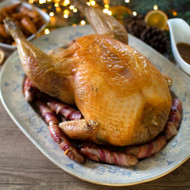How Britain Fell In Love With The Roast Turkey
Posted by The Turkey Team on 14th Feb 2022
Whether one follows their head or their heart, it is not difficult to see why Britain loves traditional turkeys.
The festive favourite is so large to be a showstopper, and when roasted creates a delicious and nutritious meal for the whole family to enjoy together with all the trimmings, vegetables and sauces you could want.
However, the story of how Britain fell in love with the Turkey dinner during a time when the goose was one of the most common roasted birds involves a grand expedition to the New World, one of the most opulent Kings of England and one of the most famous novels in history.
The Flight Of The Flightless Bird
Turkeys are a native bird of the Americas and were common in the Aztec Empire of Central America before European nations began to explore the continent in the 15th and 16th centuries.
The name of the birds has only a tangential relationship with the country of Turkey, as when the bird was first discovered they were believed to be a type of guinea fowl, a bird that was at the time imported from Turkey into Europe and was often simply known as a turkey fowl.
Exactly how the first turkeys made it to the UK is unclear as there were two ways Britain obtained its earliest turkeys and it is not known which came first.
One option is through the Spanish, who were the first to explore America substantially, the first country to take Aztec turkeys back to Europe and had traded them with the British.
However, another story that is popularly retold is that English landowner, explorer and later Member of Parliament William Strickland, who allegedly acquired six turkeys on a voyage to America in 1526 and would later receive a family crest with a turkey taking pride of place.
The two stories are not necessarily mutually exclusive, but the question of which came first remains unclear to this day.
The Many Banquets Of Henry VIII
King Henry VIII was famous in his later years for his often voracious appetite, to the point that he had 200 people in his kitchen staff alone and Hampton Court Palace’s royal kitchens were 55 rooms.
Amidst the large black puddings, spit-roasted boar, whale meat and beaver tails were many different types of birds that were both native and exotic.
Prior to Henry VIII eating his first turkey, the most popular royal roast bird was the Peacock, with its plumage being a centrepiece of the banquet and its beak was covered in gold leaf.
Turkey was the preferred bird, however. It was more exotic, tasted much better and was much larger, making it far more of a show-piece dish.
It would take less than a century for turkeys to become a common bird throughout the country and start their path towards being a traditional festive roast, at least for the rich.
From Goose To Turkey
In some circles you can hear the term ‘Christmas goose’ and the reason for this is that the turkey and the goose were representatives of a fundamental class divide in the 18th and 19th centuries.
The roast dinner had become universally popular by the 19th century, and whilst the likes of pheasant, boars, peacocks and swans would fill the ornate tables of the landed gentry, the middle and working classes would tend to opt for chicken or pigeon.
Goose was usually a special festive roast for the middle class, and savings clubs were commonly found to help families save up for the Christmas goose.
This changed in part due to the railways making produce from around the country more easily available, but also due to an 1843 book that most people will be aware of.
Charles Dickens’ A Christmas Carol was so famous and so successful that it created a wealth of Christmas traditions almost single-handedly, but the most enduring is that at the end of the book, when Ebeneezer Scrooge has a change of heart, he buys his employee the largest turkey he can.
This helped increase its popularity, although it would take until more modern rearing methods for it to become a ubiquitous part of the Christmas Dinner.



